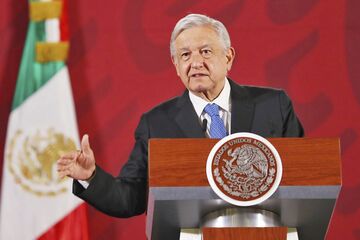- Latin American nation had blocked Thursday’s agreement
- OPEC delegates say they’re unaware of terms of Amlo-Trump pact

Mexico said it has reached an oil-production cuts agreement with OPEC+ after an intervention from U.S. President Donald Trump resolved an overnight impasse, although it was unclear whether Saudi Arabia had accepted the proposal.
Speaking at a press conference on Friday morning, Mexican President Andres Manuel Lopez Obrador said he and Trump reached an accord on a level of production cuts that was more acceptable than the 400,000 barrel-a-day reduction proposed by OPEC+ on Thursday.
Separately in Moscow, Kremlin spokesman Dmitry Peskov told reporters that President Vladimir Putin considers the OPEC+ deal to be fully agreed and regards it “very positively.” However, delegates from the Organization of Petroleum Exporting Countries said they were unaware of the terms of the deal to which Mexican leader was referring.
If the standoff between Mexico and OPEC+ has indeed been resolved, it opens the way for a historic effort to revive the oil market from a debilitating coronavirus-induced slump. The deal by the coalition of nations known as OPEC+, which dwarfs previous interventions, would end the price war between Riyadh and Moscow that helped push oil down to the lowest in almost two decades.
All of that was in doubt on Thursday night after Saudi Arabia made the whole deal dependent on Mexico’s participation, despite the country’s refusal to cut as deeply as required. The kingdom’s energy minister, Prince Abdulaziz bin Salman, was pinning an accord to remove more than 10% of global production from the market on an argument about a few hundred thousand of barrels, but he was determined that the burden of cuts must be shared as widely as possible.
When asked about Mexico’s refusal to significantly reducing its oil production, Lopez Obrador said Trump had given him assurances that the country can make a smaller curb.
“First they asked us for 400,000, then 350,000” but Mexico was only able to cut by 100,000 barrels a day, said Lopez Obrador. Trump’s “very generously expressed to me that they were going to help us with an additional 250,000 to what they are going to contribute. I thank him.”
OPEC+ has been put under intense pressure to do a deal by Trump and American lawmakers, who fear thousands of job losses in the U.S. shale patch. Yet the American president hasn’t promised to make deliberate production cuts. Instead, he will let market forces do their work, allowing low prices to deliver “automatic” output curbs.
That sentiment was reiterated by his energy secretary Dan Brouillette in opening remarks at Group of 20 meeting on Friday. He predicted a decline of nearly 2 million barrels a day in U.S. output by the end of this year.
G-20 Meeting
Attention now turns to the call between the G-20 energy ministers, where OPEC+ is hoping to secure commitments for 5 million barrels a day of production cuts in addition to the initial 10 million reduction in its own output proposed on Thursday.
“The extreme volatility we are seeing in oil markets is detrimental to the global economy at a time when we can least afford it,” said Fatih Birol, the head of the International Energy Agency, who’s been a key figure in the diplomatic effort to broker a global deal.
A 15 million barrel-a-day production cut would be unprecedented, but still be just a fraction of the 20 million to 35 million barrels a day in estimated global demand losses as billions of people stay confined to their homes and businesses close to slow the spread of the coronavirus.
West Texas Intermediate crude plunged more than 9% on Thursday, settling at below $23 a barrel, as traders and analysts said the cut was too small to prevent an oversupply of crude.
Not Enough
“With demand likely down 20% this quarter, we believe the agreed cuts won’t be enough to prevent oil inventories from rising sharply over the coming weeks,” said Giovanni Staunovo, commodity analyst at UBS Group AG.
The OPEC+ deal would result in cuts of about 10 million barrels a day during May and June, shrinking to 8 million a day from July and then 6 million a day from January 2021 to April 2022, according to the OPEC statement. The group is planning another videoconference June 10 to discuss what additional measures need to be taken.
Saudi Arabia and Russia, the biggest producers in the group, would initially each take output down to about 8.5 million a day, with all members agreeing to cut supply by 23%.
The size of the reduction highlights the depth of the market’s crisis. Opening Thursday’s meeting, OPEC Secretary-General Mohammad Barkindo described the supply-demand balance as “horrifying.” But it will probably buy producers little more than a bit of time.
“For oil markets, the massive oil-demand contraction is unprecedented,” OPEC said in an internal document circulated to ministers and seen by Bloomberg. “The current outlook looks extremely bleak, with oil markets anticipated to be severely tested on many fronts.”
SOURCE: Bloomberg


